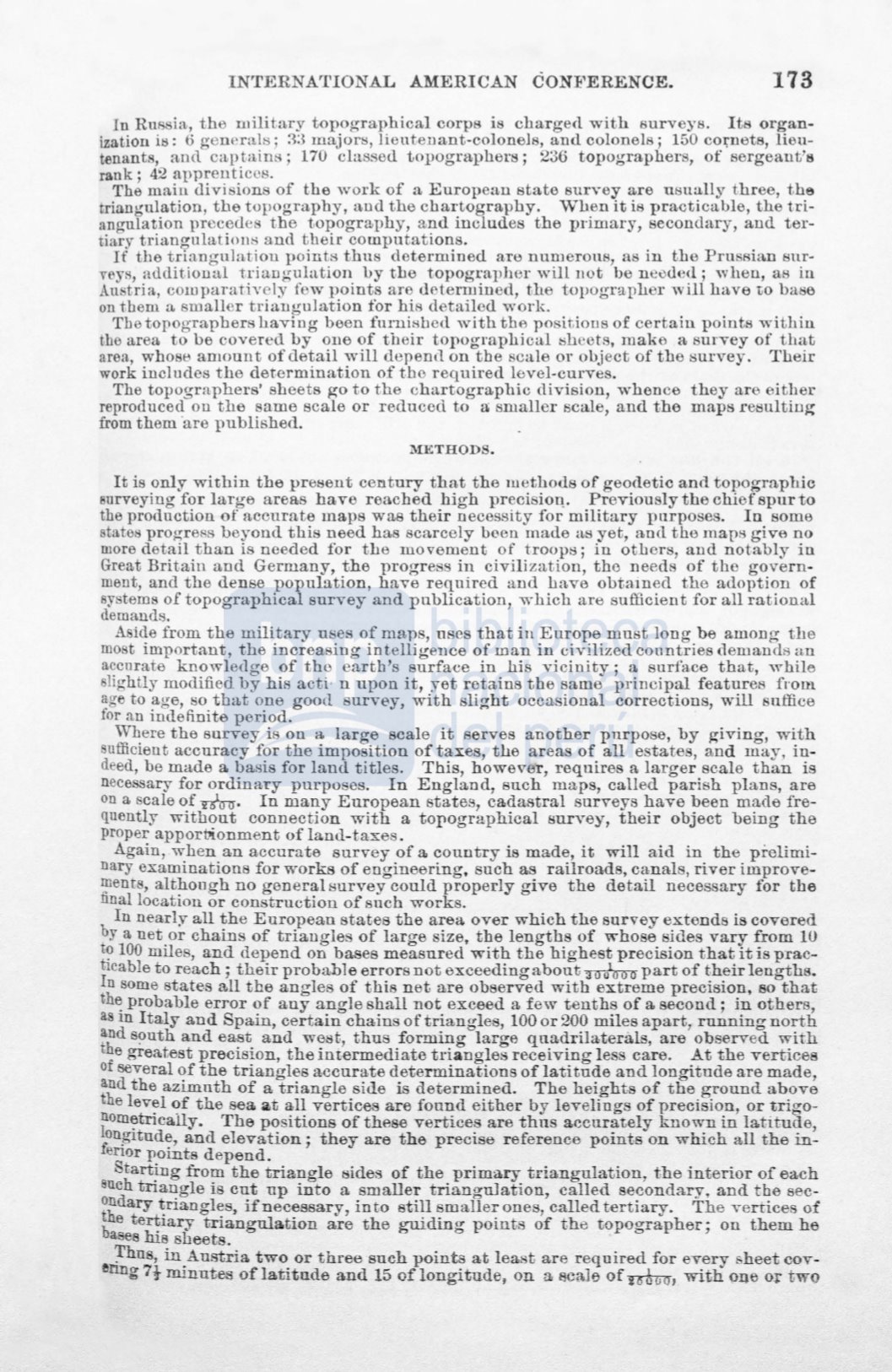

IN'fERNATIONAL AMERICAN CON:E'ERENCE.
173
In Russia, the military topographical corps is charged with surveys. Its organ–
ization is :
o
genera
lo; 3:3
majors, lieutenant-colonels, and colonels;
150
c01;nets, lieu–
tenants, and cap.tains ;
170
classed topographers; 236 topographers, of sergeaut's
rank; 42 apprentLCcs.
The main divisions of the work of a European state survey are usually three, the
trian.,.ulation, the topograpby, aud the cha1·tograpby. When it is practicable, the tri–
angulatiou precedes the topograpby, and includes the primary, secondary, aud ter–
tiary trian<Yulatiom; and their computations.
lf
the trlangulatiou points thus determined are numerons, as in the Prussian snr–
vey., additional triaugulation by
t.betopographer will 11ot be needed; when, as in
L\.n
·tria, comparatively few points are determiued, the topograpber will have to base
on tbem a smaller triangulation for his detailed 'York.
Tbetopographers baviug been furnisbed '"ith the positious of certain points within
the area to be covered by one of tbeir topographical sheets, make a survey of that
area, whose amount of detail will depend on tbe scale or object of the survey. Their
work includes the determination of tho required level-curves.
The topogrn.phers' sheets go to the chartograpbic diYision, whence they are either
reproduced ou tbe same scale or reduced to a srualler scale, and the maps resulting
from
them ·are pnblished.
METHODS.
It
is only within the present century that t h e methods of geodetic
anrl
topograpbic
surveying for large areas have reached high precisioq. Previouslythechiefspurto
the prodnction of accurate maps was their necessity for military purposes. In sorne
states progress beyond this need has scarcely boen made as yet, and the maps give no
more detail than ís needed for the movement of troops; in others, and notably in
Great Britain and Germany, the progresa in civilization, thc needs of the govern –
ment, and tbe dense popul:1tion, have required and have obtamed the adoption of
systems of topographical survey and publication, 'vhich are sufficient for all rational
demands.
A.side from the military uses of maps, uses that in Europe must long be amoug the
most important, the iucreasing intelligence of man in civilized con utries demanda
~1n
a.ccnrate knowledge of tbo eartb's surfaee in bis viciuity; a surface that, while
lightly modified. by his acti· n upon it, yet reta,ins the same principal feature from
~ge
to
age, so tbat one good snrvey, with slight occasional corrections, will
su.ff:ice
for an indefinite period.
Where the survey is on a large scale it serves auother pnrpose, by giving, with
sufficient accuracy for the imposition
ofta:x.es,the a reas of all estates, and may, in–
deed, be
ma.dea basis for land titles. This, however, requires a larger scale than is
necessary for ordinary purposes. In England, such maps, called parisb plaus, are
on a scale of
~·
In many European states, cadastral surveys have been macle fre–
quently without connection witb a topographical survey, their object being the
proper apporVionment of land-taxes.
A.gain, when an accurate survey of a country is made, it wi1l aid in the prelimi–
nary examinations for works of engiueering, sucb as railroads, canals, river improve–
~ents,
although no general survey could properly give the
deta.ilnecessary for the
finallocation or construction of such works.
In nearly all the Europeau states the area over which the survey extends is covered
by
a net or chains of triaugles of large size, tbe lengths of whose sides vary from
10
t?
lOO
miles, and depend on bases measured with the bighest precision that it is prac–
ticable to reach; their probable errors not e:x.ceeding about
auo~
part of their lengtbs.
In sorne states all the angles of this n et are observed witb extreme precision, so that
th~
probable error of any angle sball not exceed a few tenths of a second ; in others,
as m Italy
a.ndSpain, certain cbains of triangles,
100
or
200
miles apart, running north
and south and east and we8t, thus forming 1arge
qnadrilaterá.ls, are observed with
the greatest precision, the intermediate triangles receiving less care. At the vertices
of several of the triangles accurate determinations of la.titude aud longitude are made,
a.ndthe azi.mnth of a triangle side
is
determined. 'fhe heights of t he gronnd above
the
lev~l
?f
the sea at all vertices are found either by levelings of precision, or trigo–
fom~trically.
'fhe positions of these vertices are tbns accurately known in latitude,
fion~1tude,
and e1evation; they are the p recise reference points on which all the
in–
enor points depend.
Sta~ng
from the triangle sides of the primary triangulation, tbe interior of each
such tnangle is cut up into a smaller triangulation, called secondary, and the sec–
~dary ~ria.ngles,
ifnecessa.ry, into stillsmaller ones, called tertiary. The v ertices of
b e
ter~aary
triangulation are the guiding points of the topographer; on them he
asea bis sbeets.
::r'hn , in Austria two or three such points at least are required for every sheet cov–
enng 7t minutes of latitnde and 15 of longitude, on a scf\le of
muo-,
with one or two
















